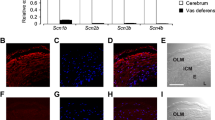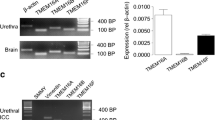Abstract
Patch-clamp experiments were performed to investigate the molecular properties of resurgent-like currents in single smooth muscle cells dispersed from mouse vas deferens, utilizing both NaV1.6-null mice (NaV1.6−/−), lacking the expression of the Scn8a Na+ channel gene, and their wild-type littermates (NaV1.6+/+). NaV1.6 immunoreactivity was clearly visible in dispersed smooth muscle cells obtained from NaV1.6+/+, but not NaV1.6−/−, vas deferens. Following a depolarization to +30 mV from a holding potential of −70 mV (to produce maximal inactivation of the Na+ current), repolarization to voltages between −60 and +20 mV elicited a tetrodotoxin (TTX)-sensitive inward current in NaV1.6+/+, but not NaV1.6−/−, vas deferens myocytes. The resurgent-like current in NaV1.6+/+ vas deferens myocytes peaked at approximately −20 mV in the current–voltage relationship. The peak amplitude of the resurgent-like current remained at a constant level when the membrane potential was repolarized to −20 mV following the application of depolarizing rectangular pulses to more positive potentials than +20 mV. 4,9-Anhydrotetrodotoxin (4,9-anhydroTTX), a selective NaV1.6 blocking toxin, purified from a crude mixture of TTX analogues by LC-FLD techniques, reversibly suppressed the resurgent-like currents. β-Pompilidotoxin, a voltage-gated Na+ channel activator, evoked sustained resurgent-like currents in NaV1.6+/+ but not NaV1.6−/− murine vas deferens myocytes. These results strongly indicate that, primarily, resurgent-like currents are generated as a result of NaV1.6 channel activity.






Similar content being viewed by others
Abbreviations
- 4,9-anhydroTTX:
-
4,9-Anhydrotetrodotoxin
- BSA:
-
Bovine serum albumin
- DAPI:
-
4′,6-Diamidino-2-phenylindole
- EJPs:
-
Excitatory junction potentials
- HEPES:
-
N-[2-Hydroxyethyl]piperazine-N′-[2-ethanesulfonic acid]
- I Na :
-
Transient voltage-gated Na+ currents
- LC-FLD:
-
Liquid chromatography-fluorescent detection
- med :
-
Motor end-plate disease
- NaV channel:
-
Voltage-gated Na+ channel
- NMDG+ :
-
N-Methyl- d-glucamine
- PBS:
-
Phosphate-buffered saline
- PSS:
-
Physiological salt solution
- TEA:
-
Tetraethylammonium
- Tris:
-
Tris(hydroxymethyl)methylammonium chloride
- Triton-X:
-
Polyoxyethylene-p-isooctylphenol
- TTX:
-
Tetrodotoxin
References
Afshari FS, Ptak K, Khaliq ZM, Grieco TM, Slater NT, McCrimmon DR, Raman IM (2004) Resurgent Na currents in four classes of neurons of the cerebellum. J Neurophysiol 92:2831–2843
Brock JA, Handelsman DJ, Keast JR (2007) Postnatal androgen deprivation dissociates the development of smooth muscle innervation from functional neurotransmission in mouse vas deferens. J Physiol 581:665–678
Catterall WA, Goldin AL, Waxman SG (2005) International Union of Pharmacology: XLVII. Nomenclature and structure–function relationships of voltage-gated sodium channels. Pharmacol Rev 57:397–409
Crill WE (1996) Persistent sodium current in mammalian central neurons. Annu Rev Physiol 58:349–362
Cummins TR, Dib-Hajj SD, Herzog RI, Waxman SG (2005) Nav1.6 channels generate resurgent sodium currents in spinal sensory neurons. FEBS Lett 579:2166–2170
Do MT, Bean BP (2003) Subthreshold sodium currents and pacemaking of subthalamic neurons: modulation by slow inactivation. Neuron 39:109–120
Do MT, Bean BP (2004) Sodium currents in subthalamic nucleus neurons from NaV1.6-null mice. J Neurophysiol 92:726–733
Gittis AH, du Lac S (2008) Similar properties of transient, persistent, and resurgent Na currents in GABAergic and non-GABAergic vestibular nucleus neurons. J Neurophysiol 99:2060–2065
Grieco TM, Malhotra JD, Chen C, Isom LL, Raman IM (2005) Open-channel block by the cytoplasmic tail of sodium channel beta4 as a mechanism for resurgent sodium current. Neuron 45:233–244
Grieco TM, Raman IM (2004) Production of resurgent current in NaV1.6-null Purkinje neurons by slowing sodium channel inactivation with beta-pompilidotoxin. J Neurosci 24:35–42
Hille B (2001) Classical biophysics of the squid giant axon. In: Hille B (ed) Ionic channels of excitable membranes, 3rd edn. Sinauer Associates Inc., Massachusetts, pp 25–60
Holman ME, Taylor GS, Tomita T (1977) Some properties of the smooth muscle of mouse vas deferens. J Physiol 266:751–764
Jarecki BW, Piekarz AD, Jackson JO 2nd, Cummins TR (2010) Human voltage-gated sodium channel mutations that cause inherited neuronal and muscle channelopathies increase resurgent sodium currents. J Clin Invest 120:369–378
Kalume F, Yu FH, Westenbroek RE, Scheuer T, Catterall WA (2007) Reduced sodium current in Purkinje neurons from NaV1.1 mutant mice: implications for ataxia in severe myoclonic epilepsy in infancy. J Neurosci 27:11065–11074
Kinoshita E, Maejima H, Yamaoka K, Konno K, Kawai N, Shimizu E, Yokote S, Nakayama H, Seyama I (2001) Nobel wasp toxin discriminates between neuronal and cardiac sodium channels. Mol Pharmacol 59:1457–1463
Kohrman DC, Harris JB, Meisler MH (1996) Mutation detection in the med and med J alleles of the sodium channel Scn8a. Unusual splicing due to a minor class AT–AC intron. J Biol Chem 271:17576–17581
Levin SI, Khaliq ZM, Aman TK, Grieco TM, Kearney JA, Raman IM, Meisler MH (2006) Impaired motor function in mice with cell-specific knockout of sodium channel Scn8a (NaV1.6) in cerebellar Purkinje neurons and granule cells. J Neurophysiol 96:785–793
Meisler MH, Kearney J, Escayg A, MacDonald BT, Sprunger LK (2001) Sodium channels and neurological disease: insights from Scn8a mutations in the mouse. Neuroscientist 7:136–145
Mercer JN, Chan CS, Tkatch T, Held J, Surmeier DJ (2007) NaV1.6 sodium channels are critical to pacemaking and fast spiking in globus pallidus neurons. J Neurosci 27:13552–13566
Nakamura M, Yasumoto T (1985) Tetrodotoxin derivatives in puffer fish. Toxicon 23:271–276
Pan F, Beam KG (1999) The absence of resurgent sodium current in mouse spinal neurons. Brain Res 849:162–168
Raman IM, Bean BP (1997) Resurgent sodium current and action potential formation in dissociated cerebellar Purkinje neurons. J Neurosci 17:4517–4526
Raman IM, Gustafson AE, Padgett D (2000) Ionic currents and spontaneous firing in neurons isolated from the cerebellar nuclei. J Neurosci 20:9004–9016
Raman IM, Sprunger LK, Meisler MH, Bean BP (1997) Altered subthreshold sodium currents and disrupted firing patterns in Purkinje neurons of Scn8a mutant mice. Neuron 19:881–891
Rosker C, Lohberger B, Hofer D, Steinecker B, Quasthoff S, Schreibmayer W (2007) The TTX metabolite 4,9-anhydro-TTX is a highly specific blocker of the NaV1.6 voltage-dependent sodium channel. Am J Physiol Cell Physiol 293:C783–C789
Shoji Y, Yotsu-Yamashita M, Miyazawa T, Yasumoto T (2001) Electrospray ionization mass spectrometry of tetrodotoxin and its analogs: liquid chromatography/mass spectrometry, tandem mass spectrometry, and liquid chromatography/tandem mass spectrometry. Anal Biochem 290:10–17
Smith MR, Smith RD, Plummer NW, Meisler MH, Goldin AL (1998) Functional analysis of the mouse Scn8a sodium channel. J Neurosci 18:6093–6102
Teramoto N, Brading AF (1996) Activation by levcromakalim and metabolic inhibition of glibenclamide-sensitive K channels in smooth muscle cells of pig proximal urethra. Br J Pharmacol 118:635–642
Yasumoto T, Michishita T (1985) Fluorometric determination of tetrodotoxin by high performance liquid chromatography. Agric Biol Chem 49:3077–3080
Yotsu-Yamashita M, Goto A, Nakagawa T (2005) Identification of 4-S-cysteinyltetrodotoxin from the liver of the puffer fish, Fugu pardalis, and formation of thiol adducts of tetrodotoxin from 4,9-anhydrotetrodotoxin. Chem Res Toxicol 18:865–871
Zhu HL, Aishima M, Morinaga H, Wassall RD, Shibata A, Iwasa K, Nomura M, Nagao M, Sueishi K, Cunnane TC, Teramoto N (2008) Molecular and biophysical properties of voltage-gated Na+ channels in murine vas deferens. Biophys J 94:3340–3351
Zhu HL, Shibata A, Inai T, Nomura M, Shibata Y, Brock JA, Teramoto N (2010) Characterization of NaV1.6-mediated Na+ currents in smooth muscle cells isolated from mouse vas deferens. J Cell Physiol 223:234–243
Acknowledgments
This work was supported by a Funding Program for Next Generation World-Leading Researcher (Noriyoshi Teramoto, Grant Number LS096; Mari Yotsu-Yamashita, Grant Number LS012) from the Japanese Society for the Promotion of Science. We thank Dr. Stevan Rakovic (OxProfs, Oxford, UK) for his helpful discussion and critical reading of the manuscript.
Author information
Authors and Affiliations
Corresponding author
Rights and permissions
About this article
Cite this article
Teramoto, N., Zhu, HL., Yotsu-Yamashita, M. et al. Resurgent-like currents in mouse vas deferens myocytes are mediated by NaV1.6 voltage-gated sodium channels. Pflugers Arch - Eur J Physiol 464, 493–502 (2012). https://doi.org/10.1007/s00424-012-1153-4
Received:
Revised:
Accepted:
Published:
Issue Date:
DOI: https://doi.org/10.1007/s00424-012-1153-4




